

Legislative Analyst's Office, August 4, 1995
The 1995 Budget Act was signed by Governor Wilson on August 3, 1995. The Budget Act and
related trailer legislation comprise a budget package that authorizes total state spending of $59.1
billion in 1995-96, consisting of $43.4 billion from the General Fund, $15 billion from special
funds, and $0.7 billion from selected bond funds. This represents an increase of 4.4 percent in
total state spending relative to 1994-95. General Fund spending will increase by $1.7 billion, or
4 percent, while spending from special funds will increase by $1.2 billion, or 8.7 percent.
The budget package does not include two major initiatives proposed by the Governor: (1) his tax reduction
proposal and (2) a realignment of state and county responsibilities.
Figure 1 describes the major General Fund changes enacted in the 1995 Budget Act and related legislation.
Optional Benefits. While the Legislature rejected the Governor's proposal to eliminate optional benefits, it did
reduce the costs of the dental program. Specifically, the budget (1) defers cost-of-living adjustments in 1995-96, for a General Fund savings of $39.8 million, and (2) reduces rates an average of 14 percent and
eliminates two procedures for an additional savings of $50.8 million.
Sponsored Aliens. The budget assumes enactment of federal legislation to prohibit immigrants who are
sponsored by a U.S. citizen from receiving Medi-Cal or Aid to Families with Dependent Children (AFDC)
benefits for five years. This would result in General Fund savings of $30 million in the Medi-Cal Program
and $24 million in the AFDC Program in 1995-96.
Transitional Care Rate. The budget establishes a higher reimbursement rate for nursing facilities (effective
January 1996) as an incentive to accept certain patients who would otherwise remain in acute care hospitals
at a higher cost. This results in an estimated General Fund savings of $30 million in 1995-96.
Qualifying Disability for SSI/SSP Benefits. The budget assumes enactment of federal legislation to
eliminate alcohol or drug abuse as a qualifying disability for the Supplemental Security Income/State
Supplementary Program (SSI/SSP) program. This would result in General Fund savings of $22 million in
SSI/SSP grants and $22 million in Medi-Cal benefits in 1995-96.
Hospital Payments. The budget assumes that the California Medical Assistance Commission
will negotiate no net increase in hospital inpatient reimbursement rates in 1995-96, for
an estimated General Fund savings of $22 million.
Federal Funds for County Administration. The budget assumes $60 million in federal
reimbursement of county administrative claims, and further provides that the state will
retain a share of these revenues, for a General Fund savings of $20 million.
Teen Pregnancy Prevention Program. The Budget Act appropriates $12 million from
the General Fund for a comprehensive teen pregnancy prevention program. Funding will
go towards a media campaign ($5.8 million), local intervention programs ($2.9 million),
an AFDC informational campaign ($1 million), and increased enforcement of statutory
rape laws ($2.4 million).
Greater Avenues for Independence (GAIN) Program. The budget includes a one-time
transfer of $20 million from the Employment Training Fund to support the GAIN
Program, for a corresponding General Fund savings in 1995-96. The budget also reflects
a General Fund reduction of $20 million for the GAIN Program, with the funding to be
replaced by a reappropriation of prior-year unexpended balances in the program. Finally,
the budget assumes AFDC grant savings of $8 million from enactment of GAIN Program
changes designed to make the program more employment-oriented (AB 1371,
Weggeland).
Edwards v. Carlson. Beginning in 1992-93, the Edwards v. Carlson decision required
the state to provide higher AFDC grants in certain cases (a caretaker relative and
nonsibling children). In 1995, the U.S. Supreme Court reversed this decision. The
budget enacts the Governor's proposal to eliminate the grant differential, for a General
Fund savings of $11.5 million in 1995-96.
Elimination of Federal Administrative Fee. The budget assumes enactment of federal
legislation, effective October 1995, to eliminate the federal fee for administering SSP
benefits, for a General Fund savings of $48 million in 1995-96.
Proposition 98 Funding. The budget provides $26.2 billion ($16.1 billion General
Fund) in Proposition 98 funding for K-14 programs in 1995-96. This exceeds the amount
provided in 1994-95 by $1.1 billion ($900 million General Fund, $150 million local
property taxes). This amount is the minimum needed to fully fund the Proposition 98
funding guarantee in 1995-96.
Figure 1 summarizes for 1994-95 and 1995-96 the effect of the budget package on the
three major recipients of Proposition 98 -- schools, community colleges, and other
agencies. As the figure shows, the funding level for K-12 schools is $4,309 per pupil for
1994-95, which is $92 per pupil more than was provided in the 1994 Budget Act. These
additional funds resulted from higher General Fund revenues that were collected during
1994-95.
The 1995 Budget sets average per-pupil funding for 1995-96 at $4,435, or $126 above
the adjusted per-pupil funding level provided in 1994-95. This increase results from
almost $850 million in new support provided through Proposition 98 above the level
needed to support the projected growth in the student population.
As Figure 1 also displays, community college funding in 1995-96 increases by
$103 million from the adjusted level provided in 1994-95. We discuss the community
college's budget in the higher education section of this report.
CTA v. Gould. The amounts contained in Figure 1 for 1995-96 reflect $360 million that will not be
immediately available to school districts. This is because these funds are appropriated contingent upon
settlement of the CTA v. Gould lawsuit, which contests the legality of $1.8 billion in Proposition 98 loans
made in the 1992 and 1993 Budget Acts. A tentative settlement of the lawsuit was developed during budget
discussions. If the lawsuit is settled, the $360 million will be distributed to schools in August 1996.
Under the proposed settlement:
Categorical Programs. The 1995 Budget Act also increases funding for K-12 categorical programs by more
than $220 million. Figure 3 displays the major funding increases. The largest amount ($136 million) was
provided in the form of a categorical block grant. Other major increases include growth and COLA funding
for certain categorical programs that are not part of the categorical mega-item ($46 million) and $26 million
set aside for a new state assessment program.
The categorical block grant generally provides growth and COLA funding to programs that are supported
through the categorical mega-item. There are two important differences, however. First, the funds are not
appropriated to any specific program. Instead, the funds are provided as a block grant that will permit
school districts flexibility to allocate the additional funds to programs funded through the mega-item.
Second, the funds are distributed in an equal amount per ADA, rather than in proportion to the amount of
categorical funds each district receives.
1994-95 Funding Increases. As discussed above, funding for schools in 1994-95 increased
by $92 per pupil due to increased General Fund revenues as part of the education trailer
legislation. The most important of these actions was the creation of a $280 million block
grant that provides K-12 districts $50 per pupil for any one-time purpose. An additional
$60 million was appropriated for deferred maintenance, instructional materials, and
education technology.
Figure 1 shows the change in funding for each major segment of higher education for 1995-96
from selected fund sources. Fee revenues shown in Figure 1 are net of financial aid for needy
students. Figure 2 shows the change in student fee levels for 1995-96.
In its budget plan for the UC, the Legislature:
The Legislature's plan also includes an unspecified reduction of $9.5 million related to the
partial backfill of the fee revenues.
We anticipate UC student enrollment to increase slightly in the budget year to reflect slight
increases in the Master Plan eligible student population. The Legislature expressed its intent in
the Supplemental Report of the 1995 Budget Act for the UC to continue to accept all applicants
who are fully eligible under the Master Plan in 1995-96 and 1996-97.
As part of its budget plan for the CSU, the Legislature rejected the administration's proposed
$156 (10 percent) general fee increase and instead provided $22.5 million from the General Fund
to backfill 75 percent of the net amount that would have been collected through the higher fees
($30 million). The Legislature also rejected an additional $90 fee increase for graduate and post-baccalaureate students, as proposed by the CSU. However, the Legislature provided no backfill
for the estimated $2.1 million in foregone fee revenues. Including funds available as a result of
charging the existing fee to additional students, the CSU will experience an increase of
$26.4 million, or 1.7 percent, above 1994-95. Excluding the one-time funding in 1994-95, the
CSU budget-year increase is $67.8 million or 4.4 percent.
The Legislature's budget plan for the CSU:
The Legislature's plan also includes an unspecified reduction of $7.5 million related to the
partial backfill of the fee revenues.
As Figure 2 shows, the Legislature rejected the administration's proposed $2 per credit unit fee
increase. This leaves community college fees at $13 per credit unit, or $390 per full-time student.
The Legislature provided almost $20 million to backfill the net amount that would have been
collected through the higher fees. The Legislature also rejected the administration's proposal to
extend the differential fee for BA degree holders--$50 per credit unit--which will expire on
January 1, 1996. However, the Legislature provided no backfill for the estimated $5 million loss
in differential fee revenues. The Legislature approved the administration's proposed reduction of
$15.2 million related to past-year declines in the enrollment of BA degree holders.
Based on current estimates of local property tax revenues by the Department of Finance (DOF),
the funding provided to community colleges for 1995-96 is sufficient to fund a 3.07 percent
COLA and 1995-96 enrollment growth of 1.17 percent. The Community Colleges Chancellor's
Office, however, has expressed concern that property tax revenues may not reach the level
projected by the DOF. To the extent that property tax revenues are less than the amount
estimated, the Chancellor's Office indicates that funding for enrollment growth in 1995-96 will
be reduced accordingly.
The 1995-96 budget for judiciary and criminal justice programs total $4.7 billion, including $4.4
billion from the General Fund and $287 million from state special funds. This amount is about
$723 million below the level proposed by the Governor in January. This reduction is primarily
due to the Legislature's rejection of the state-county realignment proposal, thereby reducing
General Fund support for the Trial Court Funding Program by $592 million below the proposed
level.
As compared to 1994-95, the General Fund amount represents an increase of $296 million, or
about 6.5 percent, above estimated spending for these programs. The budget assumes that the
state will receive $413 million in federal funds to offset the costs of incarcarating and
supervising undocumented felons in state prison and the Youth Authority. If General Fund
expenditures are adjusted to account for these federal funds (as the Governor did in his January
budget), total General Fund expenditures would actually decrease by $84 million, or 1.8 percent.
Figure 1 and the following text describe the major changes in the 1995 Budget Act relative to the
Governor's Budget.
The 1995 Budget Act provides $165 million for support of the judiciary, which includes the
California Supreme Court, the Courts of Appeal, Judicial Council, and the Commission on
Judicial Performance. This represents an increase of $14.2 million, or 9.4 percent, above 1994-95 expenditures. The increase is primarily due to caseload and rate increases for court-appointed
counsel services and increased staffing to legislatively-approved levels.
Inmate and Parole Caseloads. The Legislature considered a number of changes that
would have saved money by reducing the number or length of stay of offenders in prison
and on parole. None of these changes were included in the final budget, however. The
budget is based on the administration's projected inmate population of about 142,500
inmates byJune 30, 1996, an increase of approximately 11 percent over 1994-95. The
parole population is projected to reach about 94,000 parolees by June 30, 1996, an increase of about 1
percent.
New Prisions. The budget includes $27 million to activate new prisons in Lassen and
Monterey Counties and to fully open a new prison in Madera County that began
activation in 1994-95. These facilities are designed to house a total of about 5,500
inmates. The budget also includes $126 million for construction of 16,500 emergency
beds in 22 existing institutions.
Federal Funds for Incarceration and Supervision of Undocumented Felons. The
budget assumes $413 million in federal funds to offset the state's costs for the
incarceration of undocumented inmates and wards in state prison and the Department of
the Youth Authority, as well as the supervision in the community of undocumented
immigrant parolees. This amount represents an increase of $380 million over the amount
the state received in 1994-95 and is about $168 million higher than existing federal
authorizations and appropriations for this purpose.
Increases in County Fees for Youth Authority Commitments. The budget assumed
enactment of a trailer bill--AB 906 (Aguiar)--with two provisions that would increase
the fees paid by counties to offset the costs of commitments to the Youth Authority.
These two provisions reduced the department's General Fund budget by $21.3 million.
The first provision would increase from $25 to $150 the monthly charges made to
counties for Youth Authority commitments, based on changes in inflation since the fee
was established in 1961. This change resulted in a General Fund savings of $11.9
million. The second provision would institute a "sliding scale" whereby counties would
pay additional fees to cover the costs of less serious offenders who are commited to the
Youth Authority. This change resulted in a General Fund savings of $9.3 million.
AB 906 has not been enacted, however.
State Support of County Probation Camps and Ranches Not Enacted. AB 906 also
includes an appropriation of $32.7 million to the Youth Authority for distribution to
counties to support county probation camps and ranches that house juvenile offenders.
Under the bill, this funding would be distributed to counties by the Youth Authority
based on criteria set forth in the bill. Approximately 21 counties would likely receive a
portion of the funds.
Omnibus Local Government Bill (AB 906, Aguiar). This bill contains various provisions affecting
counties:
A third companion bill--SB 75, Polanco--was intended to provide relief to Los Angeles and Orange
Counties by allowing them to spend local transportation funds for general purposes. This measure was
vetoed by the Governor.
Negotiations are underway, but not completed, for new MOUs for 1995-96. The budget
does not include funds for new employee compensation costs that may be included in
these prospective MOUs. Any MOUs requiring the expenditure of state funds would be
subject to approval by the Legislature through the enactment of legislation.
The 1995 budget provides about $652 million for environmental protection programs,
including about $589 million for various environmental protection agencies, and
$63 million for local assistance.
The budget provides $2.4 billion for transportation capital outlay projects. This includes
$56 million for toll bridge seismic retrofit through March 1996, to be provided from the
State Highway Account ($45 million) and from toll bridge revenues ($11 million). The
budget also appropriates for seismic retrofit, $81 million from an anti-trust lawsuit
settlement against oil companies. Additional funds for seismic retrofit are contained in a
bond measure to be on the March 1996 ballot.
The budget provides $840 million for local assistance programs administered by
Caltrans--about 7.6 percent less than in 1994-95. The reduction results mainly from
appropriating $100 million for the State-Local Transportation Partnership Program,
rather than the statutory level of $200 million. The budget provides $71 million for
operating assistance to the local transportation authorities through the State Transit
Assistance (STA) program, a 4 percent increase over the 1994-95 level. The budget also
provides $40 million for the Transit Capital Improvement (TCI) program, a 36 percent
increase.
Budget Overview
Major Features of the Budget Package
The budget package is designed to eliminate the $629 million deficit carried over from 1994-95 and end
1995-96 in balance with a marginal reserve, as shown in Figure 1. Major features of the budget include the
following: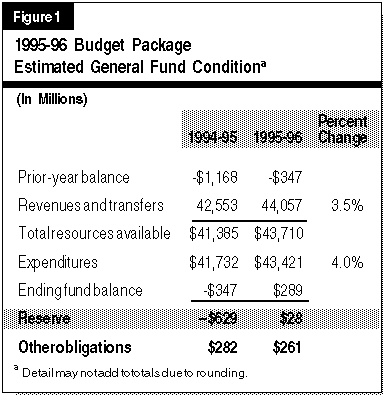
Actions to Close the Budget Gap
Based upon the May Revision of the Governor's Budget, we estimated that the state faced a $1.8 billion budget
gap. The gap consisted of a carryover deficit from 1994-95 of $848 million, plus an operating shortfall in 1995-96 of about $950 million. The final budget gap dropped to about $1.3 billion as shown in Figure 2, as a result of
improved revenue collections late in 1994-95 and downward adjustments to estimated growth of K-12
enrollment and welfare caseloads. Figure 2 also shows how the elements of the 1995-96 budget package
resolved that gap. The budget solutions can be summarized as follows:
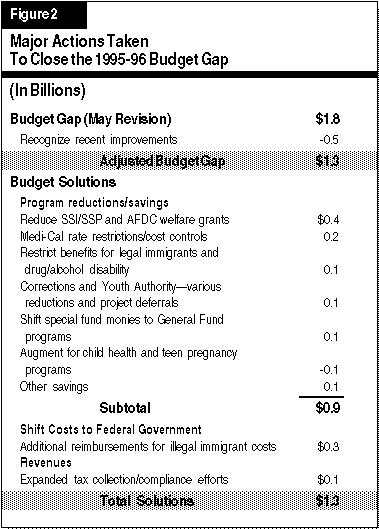
Budget Relies on Federal Actions
Figure 3 shows that the budget relies on federal actions to achieve almost $800 million of savings. In addition to
funding for immigrant costs, almost all of the savings from welfare grant reductions and eligibility restrictions
require either federal legislation or a federal administrative waiver. Furthermore, $245 million currently
authorized for the incarceration of illegal immigrant felons remains contingent on final federal budget actions.
Consequently, the success of the state's 1995-96 budget plan depends to a large extent on the actions of
Congress and the Clinton Administration.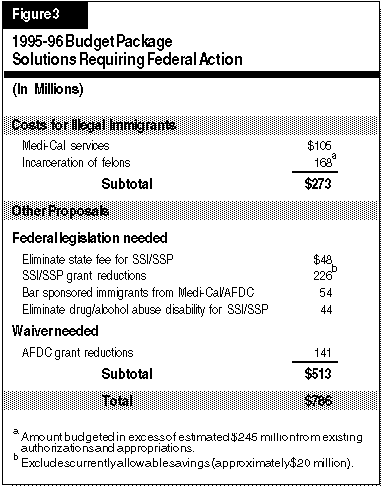
Health and Welfare
General Fund support for health and welfare programs in 1995-96 totals $13.9 billion, a decrease of less than 1
percent from the prior year.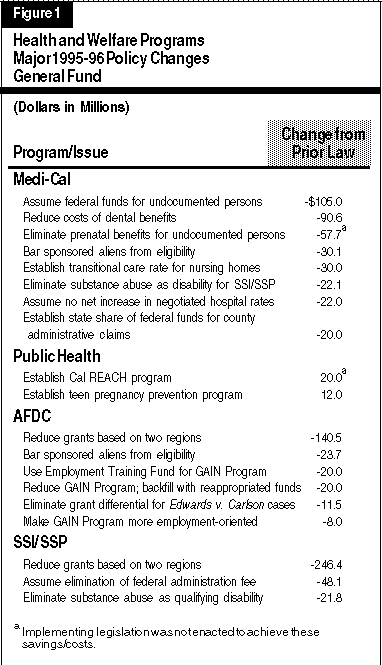
Medi-Cal Program
Services to Undocumented Persons. The budget assumes receipt of $105 million in federal funds to partially
offset state costs for emergency health services provided to undocumented immigrants. The budget also assumes
elimination of the state-only program providing prenatal benefits to undocumented women, for a General Fund
savings of $58 million in the budget year. However, implementing legislation was not enacted to achieve these
savings.Public Health
Reaching Early Access for Children's Health (REACH) Program. The budget includes
$20 million from the General Fund (and $20 million in assumed federal funds) to
provide outpatient health care services to children in low-income households, effective
April 1996. Eligibility for REACH is restricted to children, aged 0-5, who are legal
residents and whose family income levels fall between 133 percent and 200 percent of
the federal poverty level. However, implementing legislation for this program was not
enacted.AFDC Program
Regional Grant Reductions. The budget reduces AFDC grants by 4.9 percent, with an
additional 4.9 percent reduction for recipients residing in low-cost counties (as
measured by rental housing costs), effective October 1995, for a General Fund savings
of $141 million in 1995-96. This will reduce the monthly grant for a three-person family
from $594 to $565 in high-cost counties and to $538 in low-cost counties. The high-cost
counties are Alameda, Contra Costa, Los Angeles, Marin, Monterey, Napa, Orange, San
Diego, San Francisco, San Luis Obispo, San Mateo, Santa Barbara, Santa Clara, Santa
Cruz, Solano, Sonoma, and Ventura. The reduction applied to all recipients will
terminate June 30, 1996, and the additional reduction to recipients living in low-cost counties
will be ongoing.SSI/SSP
Regional Grant Reductions. The budget reduces SSI/SSP grants by 4.9 percent, with an
additional 4.9 percent reduction for recipients residing in low-cost counties, effective
December 1995, for a net General Fund savings of $246 million in 1995-96. This will
reduce the monthly grants for aged and disabled individuals (the largest category of
recipients) from $614 to $584 in high-cost counties and to $555 in low-cost counties.
The reduction applied to all recipients will terminate June 30, 1996, and the additional
reduction to recipients living in low-cost counties will be ongoing.
Proposition 98 Education
The major features of the budget package as it relates to the Proposition 98 minimum
funding guarantee and K-12 schools are contained in Ch 308/95 (AB 825, W. Brown, et
al.).Proposition 98 Provisions
The Proposition 98 portion of the budget package:
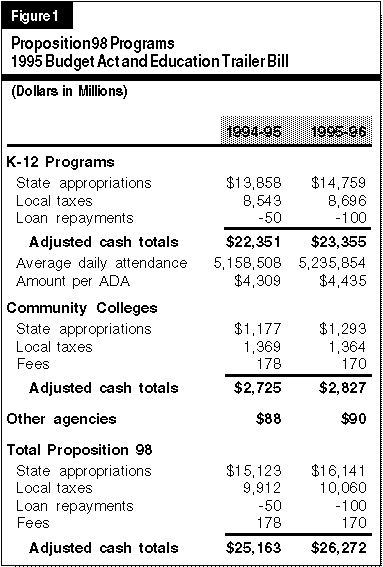
K-12 Program Impacts
General Purpose Funding. The budget provides a total of $17 billion ($8.72 billion General Fund) for
general purpose funding to school districts and county offices of education in 1995-96. This represents an
increase of $117 per pupil from the amount provided in 1994-95. Figure 2 displays the major actions that
result in the 1995-96 increase. As the figure illustrates, in addition to providing a 2.7 percent COLA, general
purpose funding is increased for all districts by an average of $33 per pupil (0.9 percent) and "low wealth"
districts are provided an equalization payment, that is designed to narrow the differences in per-pupil
funding among school districts.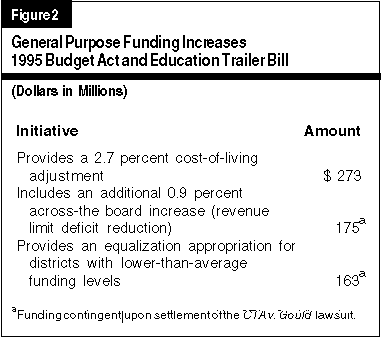
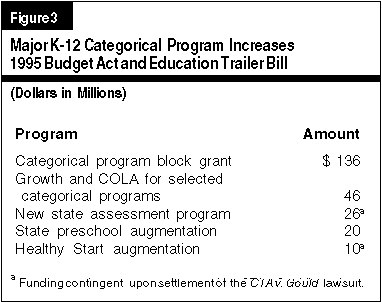
Higher Education
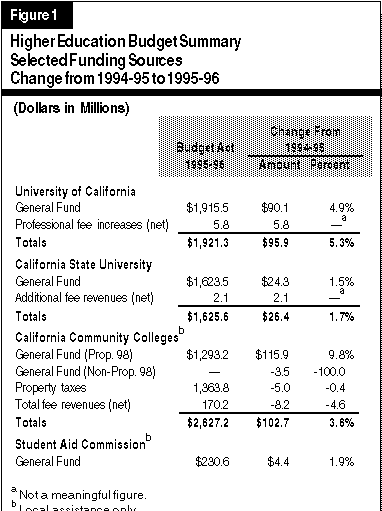
The University of California (UC)
The 1995 Budget Act provides $90.1 million (4.9 percent) more in General Fund support for the
UC in 1995-96 compared to 1994-95. The Legislature rejected the administration's proposed
$380 (10 percent) general fee increase and instead provided $28.5 million from the General Fund
to backfill 75 percent of the net amount that would have been collected through the higher fees
($38 million). The Legislature approved fee increases of up to $2,000 for new students enrolled
in professional programs (law, business, medicine, dentistry, and veterinary medicine), as
proposed by the UC. Including funds available as a result of the professional student fee
increases, the UC will experience an increase of $95.9 million, or 5.3 percent, above 1994-95.
The California State University (CSU)
The 1995 Budget Act provides $24.3 million (1.5 percent) more in General Fund support for the
CSU in 1995-96 compared to 1994-95. The increase understates actual budget-year growth, as
1994-95 expenditures included $41 million in one-time spending.
California Community Colleges
The 1995 budget package increases funding for community colleges local assistance by
$102.7 million (3.8 percent) compared to the revised 1994-95 appropriation. The Legislature's
budget actions also increase the community colleges' 1994-95 General Fund appropriation by
$73 million--$47 million to backfill a local property tax shortfall and $26 million for deferred
maintenance and instructional equipment.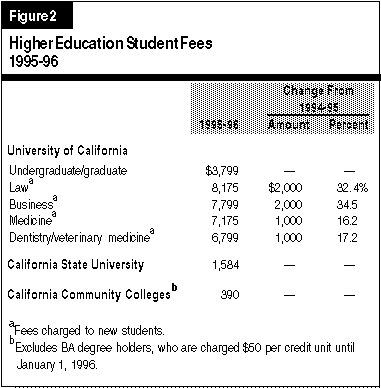
Judiciary and Criminal Justice
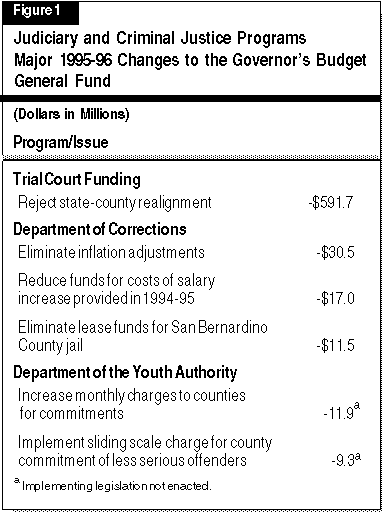
Judiciary
Trial Court Funding
In January, the Governor proposed about $1.3 billion for support of the Trial Court Funding
Program, which was roughly a two-fold increase, as part of his state and county restructuring
proposal. The Legislature ultimately rejected the proposal and deleted $592 million of the
proposed increase. Thus, the budget provides a total of $663 million ($508 million from the
General Fund and $155 million from special funds) for support of local trial courts in 1995-96.
This level of state support covers about 37 percent of statewide trial court expenses in 1995-96,
or about 1 percent more than the state paid in 1994-95. Department of Corrections
The budget provides a total of $3.3 billion ($3.2 billion from the General Fund and $59 million
from special and bond funds) for support of the California Department of Corrections (CDC).
This represents an increase of about 8 percent above the 1994-95 level and is primarily due to
projected increases in inmate and parole populations. The most significant reductions below
the level initially requested by the Governor in January were elimination of funds for
inflation adjustments ($30.5 million), reduction in funds for the annualized costs of
employee pay increases granted in 1994-95 ($17 million), and elimination of funds
proposed to lease a jail in San Bernardino County in order to house state prison inmates
($11.5 million). The budget also includes a net reduction of about $38.1 million below
the January request to reflect changes in caseload estimates contained in the May
Revision.Department of the Youth Authority
The budget provides $345 million ($343 million from the General Fund and $1.5 million
from special and bond funds) for support of the Department of the Youth Authority. The
General Fund amount is $13.4 million, or 3.7 percent, less than 1994-95 expenditures.
The budget includes an augmentation of $9.7 million ($6.4 million from the General
Fund and $3.3 million from Proposition 98) to cover the costs of the projected increase
of 5.5 percent in the Youth Authority's ward population and 4.8 percent in the parole
population. These increases were offset by elimination of one-time expenditures in
1994-95 and reductions resulting from increases in fees charged to counties for
commitments to the Youth Authority.
Other Major Provisions
Local Government
Two budget companion bills which would provide counties fiscal relief and greater program flexibility were
passed by the Senate and are under consideration by the Assembly.
Transfer of Special Funds
In recent years, amounts have been transferred from special funds to the General Fund to finance certain
state activities. Figure 1 shows the major transfers for 1995-96.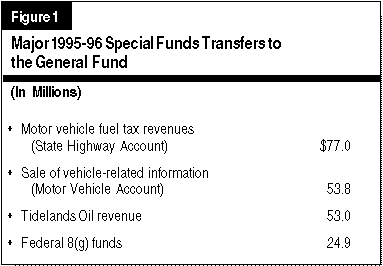
Employee Compensation
Under approved memoranda of understanding (MOUs), represented state employees
(other than employees of the University of California and the California State
University) received a 3 percent general salary increase (GSI) on January 1, 1995. The
Department of Personnel Administration approved an identical increase for
nonrepresented employees. The 1995-96 costs due to this GSI, however, are funded in
the budget only for that portion attributable to employees directly engaged in public
safety, 24-hour care, or revenue-generating activities within 15 specified departments.
The amounts needed to pay the GSI to other state employees must be borne by
departments and agencies from existing support funds.Resources and Environmental Protection
The 1995 budget provides a total of about $1.0 billion for resources programs, including
about $834 million to support various resources agencies and conservancies, and $162
million for local assistance and capital outlay. Significant features of the budget include:
Transportation
The 1995 budget provides about $1.6 billion for support of the Department of
Transportation (Caltrans)--about 5 percent less than in 1994-95. This amount reflects a
$67 million reduction proposed in the Governor's Budget, as well as reductions of $58
million taken by the Legislature. Specifically, the Legislature eliminated $28 million
proposed to fund a salary increase and also cut $30 million from various programs
including administration, vehicle purchase, and local planning grants. The budget
includes $18 million for Caltrans to comply with a court order that it reduce toxic
contamination of wastewater runoff from roads and from Caltrans' facilities.Capital Outlay
The budget includes $690 million (about 80 percent from bonds) for capital outlay, as
shown in Figure 2. Of the $570 million in total bond funding, about $500 million is from
newly authorized lease-payment bonds, mainly for higher education and the Department
of Corrections. The remaining $70 million is from various general obligation bond
funds. The budget also funds capital outlay from the General Fund ($45 million), various
special funds ($57 million), and federal funds ($18 million). The Department of
Corrections' total includes $126 million for emergency housing to add 16,500 beds at 22
prisons and at conservation camps.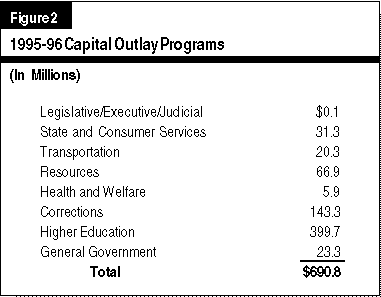
Appendix 1: Trailer Legislation
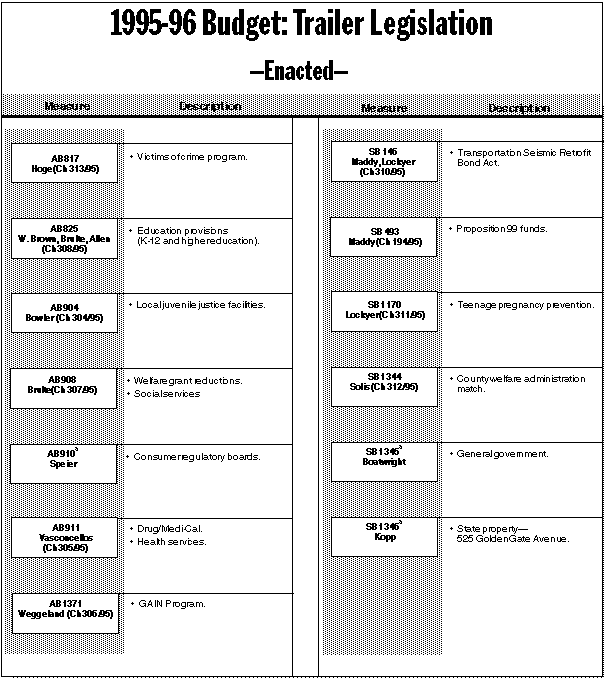
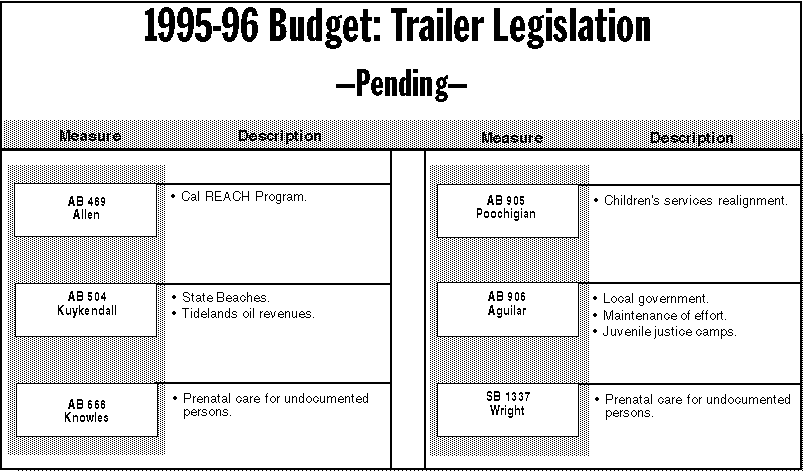

Return to LAO Home Page